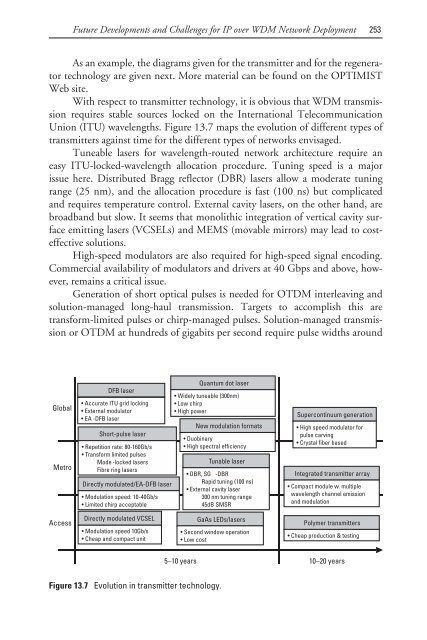deploying and managing ip over wdm networks - Index of
deploying and managing ip over wdm networks - Index of
deploying and managing ip over wdm networks - Index of
Create successful ePaper yourself
Turn your PDF publications into a flip-book with our unique Google optimized e-Paper software.
Future Developments <strong>and</strong> Challenges for IP <strong>over</strong> WDM Network Deployment 253<br />
As an example, the diagrams given for the transmitter <strong>and</strong> for the regenerator<br />
technology are given next. More material can be found on the OPTIMIST<br />
Web site.<br />
With respect to transmitter technology, it is obvious that WDM transmission<br />
requires stable sources locked on the International Telecommunication<br />
Union (ITU) wavelengths. Figure 13.7 maps the evolution <strong>of</strong> different types <strong>of</strong><br />
transmitters against time for the different types <strong>of</strong> <strong>networks</strong> envisaged.<br />
Tuneable lasers for wavelength-routed network architecture require an<br />
easy ITU-locked-wavelength allocation procedure. Tuning speed is a major<br />
issue here. Distributed Bragg reflector (DBR) lasers allow a moderate tuning<br />
range (25 nm), <strong>and</strong> the allocation procedure is fast (100 ns) but complicated<br />
<strong>and</strong> requires temperature control. External cavity lasers, on the other h<strong>and</strong>, are<br />
broadb<strong>and</strong> but slow. It seems that monolithic integration <strong>of</strong> vertical cavity surface<br />
emitting lasers (VCSELs) <strong>and</strong> MEMS (movable mirrors) may lead to costeffective<br />
solutions.<br />
High-speed modulators are also required for high-speed signal encoding.<br />
Commercial availability <strong>of</strong> modulators <strong>and</strong> drivers at 40 Gbps <strong>and</strong> above, however,<br />
remains a critical issue.<br />
Generation <strong>of</strong> short optical pulses is needed for OTDM interleaving <strong>and</strong><br />
solution-managed long-haul transmission. Targets to accomplish this are<br />
transform-limited pulses or chirp-managed pulses. Solution-managed transmission<br />
or OTDM at hundreds <strong>of</strong> gigabits per second require pulse widths around<br />
Global<br />
Metro<br />
Access<br />
DFB laser<br />
Accurate ITU grid locking<br />
External modulator<br />
EA -DFB laser<br />
Short-pulse laser<br />
Repetition rate: 80-160Gb/s<br />
Transform limited pulses<br />
Mode -locked lasers<br />
Fibre ring lasers<br />
Directly modulated/EA-DFB laser<br />
Modulation speed: 10-40Gb/s<br />
Limited chirp acceptable<br />
Directly modulated VCSEL<br />
Modulation speed 10Gb/s<br />
Cheap <strong>and</strong> compact unit<br />
Quantum dot laser<br />
Widely tuneable (300nm)<br />
Low chirp<br />
High power<br />
New modulation formats<br />
Duobinary<br />
High spectral efficiency<br />
Tunable laser<br />
DBR, SG -DBR<br />
Rapid tuning (100 ns)<br />
External cavity laser<br />
300 nm tuning range<br />
45dB SMSR<br />
GaAs LEDs/lasers<br />
Second window operation<br />
Low cost<br />
Figure 13.7 Evolution in transmitter technology.<br />
Supercontinuum generation<br />
High speed modulator for<br />
pulse carving<br />
Crystal fiber based<br />
Integrated transmitter array<br />
Compact module w. mult<strong>ip</strong>le<br />
wavelength channel emission<br />
<strong>and</strong> modulation<br />
Polymer transmitters<br />
Cheap production & testing<br />
5–10 years 10–20 years


